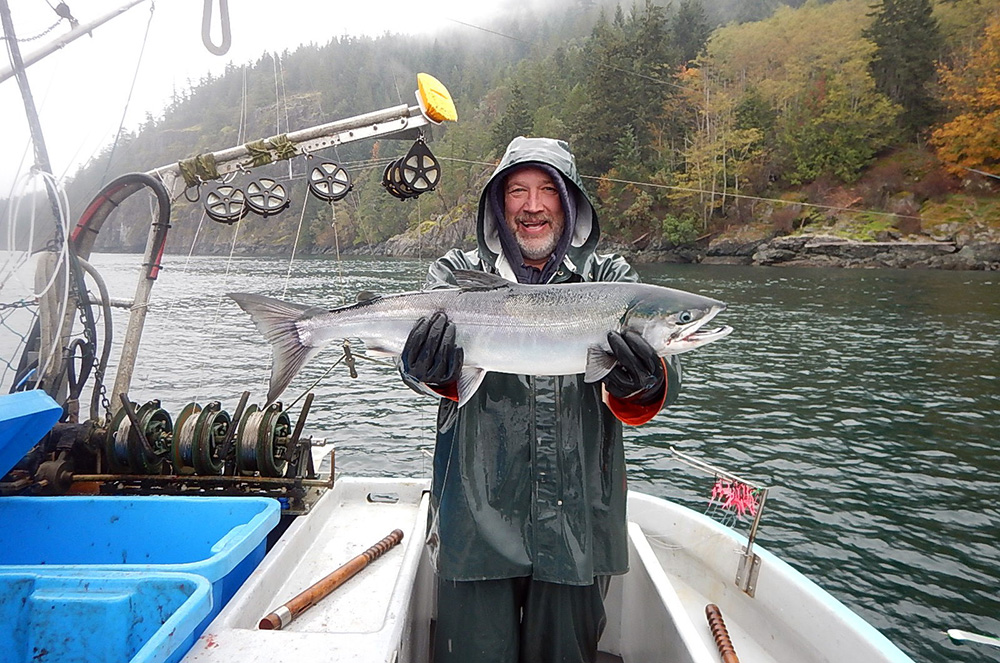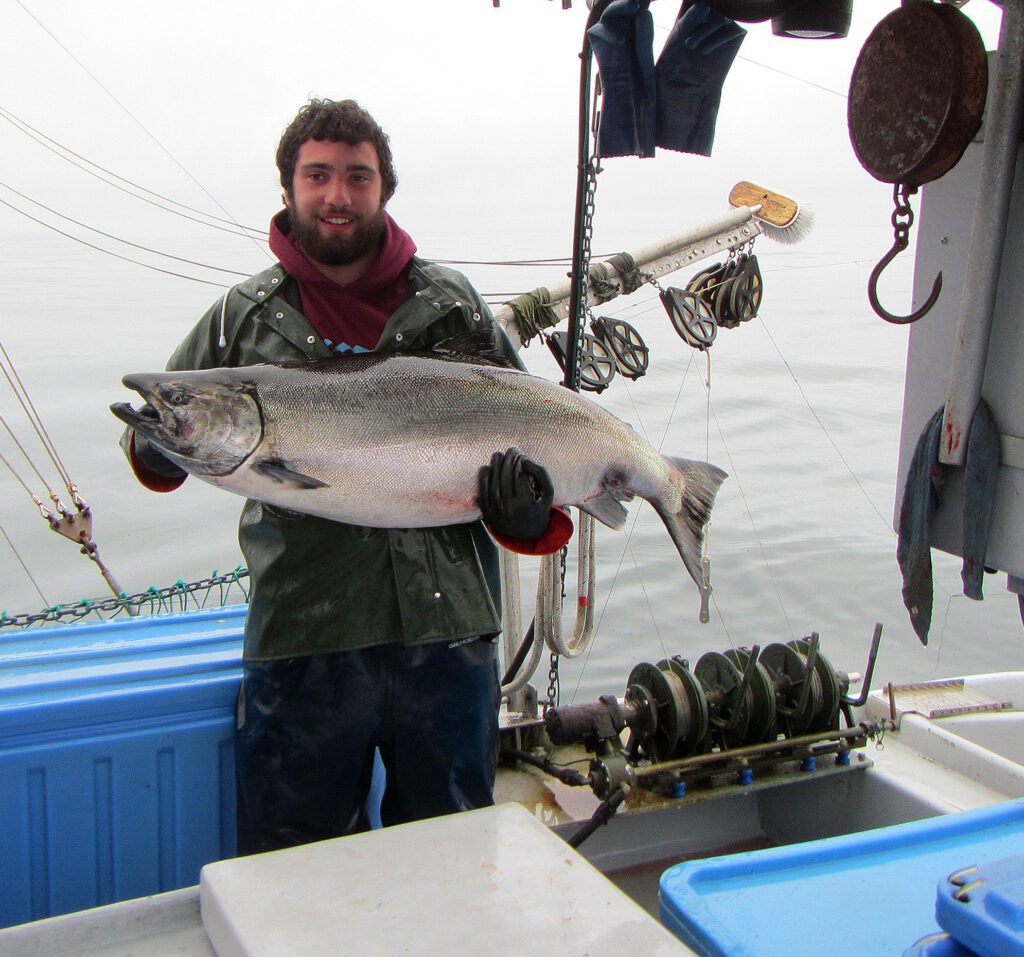
Pacific salmon are fundamental to the livelihoods, culture and spiritual lives of thousands of British Columbians, as they are in America’s Pacific Northwest and Alaska. Sadly, climate change, habitat degradation and foreign market competition are leaving them exceedingly vulnerable.
“Many key Pacific salmon stocks are declining to historic lows, facing persistent and severe challenges at every stage of their lifecycle due to the negative impacts of climate change, habitat degradation, land and water use, acute events like toxic spills and landslides and harvest pressure,” Lara Sloan, communications adviser to Fisheries and Oceans Canada (DFO), told Fishermen’s News.
“The planet is warming, and the most recent years have been the warmest on record,” Sloan noted. “In Canada, the rate of warming has been twice the global average and is even greater at northern latitudes.”
A 2019 DFO report on the status of Pacific salmon outlined how salmon are responding to climate and habitat changes. Northeast Pacific Ocean temperatures, which have steadily increased since 1950, proved particularly brutal from 2013 to 2017, when an extremely strong marine heatwave, nicknamed “The Blob,” impacted ocean food webs.
A strong El Niño event from late 2015 to early 2016 caused further warming in this area, leading to the hottest ocean temperatures observed in 137 years of monitoring.
The report predicted that extreme marine heatwaves and El Nino events will become more common with climate change.
Stemming historic declines and rebuilding key Pacific salmon populations are the overarching goals of the historic $647 million Pacific Salmon Strategy Initiative (PSSI) launched in June 2021 by DFO. The funding is earmarked to stem declines in salmon runs while helping rebuild adaptable populations over the longer term.
“While there are many stressors that affect Pacific salmon survival, climate change is rapidly superseding these threats,” Sloan said.
“In 2021-22, PSSI provided increased funding for climate change research, building on the 2019 State of Pacific Salmon report, as well as introducing key activities and collaborative efforts needed to reduce the vulnerability of our social, economic and ecological systems to climate change,” she added.

The earlier report described some general patterns in Canadian Pacific salmon abundances emerging concurrent with climate and habitat changes. Researchers found Chinook numbers on the decline throughout their BC and Yukon range, and sockeye and coho numbers declining most notably at southern latitudes.
They found salmon that spent less time in freshwater —pink, chum, river-type sockeye and ocean-type Chinook—were generally not exhibiting long-term declines.
Ongoing Research, Efforts
Ongoing research into the challenges facing salmon are proving that salmon, like other species groups, vary in their vulnerability to the threats posed by climate, temperature change and varieties of pollution in waters that are critical to salmon at various life stages.
Meanwhile, DFO officials say they’re undertaking a wide range of efforts related to harvest habitat and hatcheries.
“For all harvesters—indigenous, commercial and recreational—we will be encouraging shifts toward more selective fishing gear, improved catch monitoring and exploring options to expand share-based management approaches in the commercial salmon fishery to support sustainable access to small harvests with improved monitoring,” Sloan said.
Some engaged in BC’s commercial fishing industry are seeing hope for the future, but for others, the glass is half empty.
“It’s disgraceful how we’ve been treated,” said Darin Chung, who represents the gillnet sector on the British Columbia Salmon Marketing Council. “DFO management has destroyed salmon fishing.”
Chung, whose family has been in the fishing business for over 75 years, said his 86-year-old father is still fishing.
“But we don’t get the fish anymore. If you are restoring programs, shouldn’t you be able to fish?” he asked.
Funding for hatchery programs has been cut, said Chung, who owns BC Live Spot Prawns & Seafood, in Delta, B.C.
“They are not spending on hatcheries,” he commented. “Hatchery fish is still wild.”
Chung is also critical of DFO’s license buyback program, under which he said gillnet licenses are being bought back by the government for $50,000.
“I can’t even buy a new truck for $50,000,” he said.
What would help? “Get me out of the industry and give me half a million and I’ll be happy,” he said.
“Fish don’t seem to be responding to recovery in any timely fashion,” according to Chris Ashton, a retired seiner who serves as executive director of the Area B Seine Association on Vancouver Island. “I don’t think anybody’s seen any results.”
Ashton noted that DFO announced in June 2021 plans to spend millions of dollars to restore fisheries.
“There haven’t been any significant programs to restore salmon,” he said. “Just a little bit of salmon restoration and a little bit of buyback.”
Sockeye salmon returns to the mouth of the Fraser River have been poor and while there was a pretty good pink salmon return “it wasn’t a very good fishery because there was no market for it, no buyers,” Ashton said. “Even on the North Coast here there is poor fishing.”
Ashton blamed below-market prices offered on Russian and Chinese fish. This has also been a big issue for other harvesters of Pacific salmon, who want the U.S. government to stop the import of seafood from countries like Russia, which have banned U.S. imports.
License Buybacks
As for license buybacks, which he estimated were about $425,000 for seine permits, they’re only buying the license, leaving fishing vessels, nets and other equipment for which there’s not a big market demand, he said.
According to DFO, commercial license holders who retire the licenses issued in their name and wish to dispose of their commercial fishing vessel and gear in an environmentally responsible way may access the Small Craft Harbours Derelict Vessel Mitigation and Gear Disposal Program.
According to its website, the license retirement program allows commercial salmon license eligibility holders to retire those licenses permanently for market value through reverse auction while facilitating the transition to a smaller commercial harvesting sector.
The program’s goal is to dispose of these vessels and gear in an environmentally friendly manner.
The big problem for the commercial sector, said Dane Chauvel, who represents the trawl sector on the British Columbia Salmon Marketing Council, is that salmon are facing an increasing environmental challenge along with increased competition from First Nations and recreational harvesters.
“Our slice of the pie and the overall pie has been reduced,” he said.
The DFO license retirement program is the right thing to do, but still falls short, said Chauvel, chief executive officer of Organic Ocean Seafood Inc., in Richmond, B.C.
“Whatever the government is offering for those licenses doesn’t afford much of a retirement,” he remarked. “It’s nice being bought out, but is it enough? No.”
“The government is targeting the gillnet licenses, and they are being paid the least,” he said. “I think they should pay more for those gillnet licenses. I think they are taking advantage of the misfortunes of that sector.”
“It’s not fair to people who have devoted their lives to providing these fish” for domestic and overseas,” he continued. “The bycatch issue, in which harvesters in some sectors are incidentally catching fish they are not targeting to harvest, is also a problem.”
“When those fish are harvested in a trawl fishery, they can’t be caught by salmon fishermen,” he added. “I think the trawlers have to be accountable for them. If I am out fishing pinks and catch too (many) sockeyes, I will be shut down. They have to be held accountable.”
Still, Chauvel said he doesn’t see any easy fixes for this problem.
“It’s above my pay grade to figure it out, but you are taking from Peter to pay Paul,” he said.
Chauvel said that overall, he sees the commercial salmon fishery of the future as a smaller industry with fewer players, but with an elevated individual standard of living.
“The direction will be to take it toward a viable commercial fishery, conducted in a sustainable fashion,” he said. “The blue economy is critical to domestic food security.”
Margaret Bauman is an Alaska journalist and photographer with an extensive background in Alaska’s industries and environmental issues related to those industries. A long-time Alaska resident, she has also covered news of national and international importance in other states on the staff of United Press International, the Associated Press, and CBS News.
